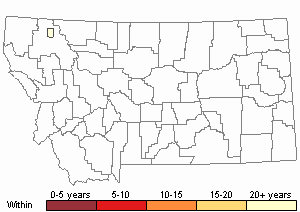View in other NatureServe Network Field Guides
NatureServe
Montana
Utah
Wyoming
Idaho
Wisconsin
British Columbia
South Carolina
Yukon
California
New York
Heller's Notchwort Liverwort - Anastrophyllum helleranum
Other Names:
Anastrophylum hellerianum, Crossocalyx hellerianus
General Description
GROWTH FORM: Leafy.
PLANTS: Tiny liverwort, 0.5-1.0 mm wide, to 8 mm long. Plants are dull greenish.
LEAVES: Transversely inserted, caniculate (trough-shaped) leaves that are bi-lobed.
Sources: Hong 1996; Stotler and Crandall-Stotler 2017.
Diagnostic Characteristics
Most leafy liverworts that grow on logs in conifer forests either lack gemmae or have red-pigmented gemmae or are much larger plants.
Lophozia longidens is the most similar small, red-gemmiferous, log dwelling leafy liverwort. It differs in being about twice as large, with leaves that are cupped at the base, but not trough-shaped along their length, and in having 2-celled gemmae. It is a very common and widespread species. Soderstrom (1993) found
Lophozia longidens most often on tree bases rather than rotten logs.
Tritomaria exsecta and
Tritomaria exsectiformis have rust-red, 2-celled gemmae, and three-lobed leaves.
Sources: Hong 1996; Hong 2002; Schuster 1969.
Range Comments
Essentially circumboreal (Hong 1996). In western North America: Alaska, Alberta, British Columbia, Idaho, Montana, Washington, Northwest Territories, and Yukon Territory. Also found in eastern Canada. In Europe: Norway, Sweden, Finland, Britain, Ireland, Germany, France, Switzerland and eastward into Russia.
Observations in Montana Natural Heritage Program Database
Number of Observations: 1
(Click on the following maps and charts to see full sized version)
Map Help and Descriptions
Relative Density

Recency


 (Observations spanning multiple months or years are excluded from time charts)
(Observations spanning multiple months or years are excluded from time charts)
Habitat
On decayed wood in shady forests. Söderström (1993) found it exclusively on wood, largely on rotten logs, occasionally on wood pieces or stumps. Schuster (1969) described habitat as shady forests on logs of intermediate decay (i.e., not freshly fallen and with bark sloughed off and wood not decayed to the point of becoming punky).
Anastrophyllum hellerianum is often found with Jamesoniella autumnalis, Lophozia longidens, Ptilidium pulcherrimum, and Tritomaria exsectiformis (Hong 1996).
Ecology
Anastrophyllum hellerianum is part of a diverse community of log-dwelling cryptogams in the forest understory. Logs suitable for Anastrophyllum hellerianum (and for most log-dwelling cryptogams) are on or close to the ground where plants can remain moist for longer (Söderström 1993).
Reproductive Characteristics
Dioicous - separate male and female liverwort plants.
Asexual reproduction is by gemmae. Gemmae are 1-celled, quadrangular, and wine-red and are found on the edges and tips of upper leaves. Gemmae-bearing shoots are usually narrower than non-bearing shoots, often attenuated, and with leaves that become smaller and more appressed toward the tips.
The perianth (a sheath encasing the female reproductive organ) is smooth below but 5-plicate above with spinous, ciliate mouths.
Management
Species-rich, log-dwelling cryptogam (bryophyte and lichen) communities are found in forests with a natural canopy density, but are absent or are species-poor in forests that have regenerated from clear-cut timber prescriptions (i.e., exhibit dog-hair tree stands). Managed forests that are thinned in order to open up the canopy are generally of poor habitat for log-dwelling species because:
* Thinning treatments may crush or turn logs, bypassing the natural slow wood decay process, and
* Opening of the canopy occurs too rapidly, resulting in a sudden increase in light intensity and a sudden decrease in humidity, which may disrupt the species-accumulation and succession process of log-dwelling cryptogam communities.
Shaded, rotting logs do not last forever. For log-dwelling communities to persist here must be other rotting logs that become available while existing substrates degrade. Logs in various decay stages must be available for log-dwelling communities to persist.
In managed forests that retain coarse woody debris, the logs are often heaped in to piles, making them unsuitable for nearly all log-dwelling cryptogam communities. Pohjano and Laaka-Lindberg (2004) stated that Anastrophyllum hellerianum “has declined in recent decades in Finland as a consequence of forestry practices”. Management that can spread out coarse woody debris will provide habitat for log-dwelling bryophytes and lichens. Logs that can contact soil in shady forests will more likely decay and at various rates.
Sources: Hong 1996; Söderström 1993.
Threats or Limiting Factors
Persistance of Anastrophyllum hellerianum requires logs in various stages of decay, which is often scarce or absent in managed forests.
Source: Pohjano and Laaka-Lindberg 2004
References
- Literature Cited AboveLegend:
 View Online Publication
View Online Publication Hong, W. S. 2002. 'A Key to the Hepaticae of Montana'. Northwest Science : Official Publication of the Northwest Scientific Association. 76: 271-285.
Hong, W. S. 2002. 'A Key to the Hepaticae of Montana'. Northwest Science : Official Publication of the Northwest Scientific Association. 76: 271-285. Hong, W.S. 1996. Anastrophyllum in Western North America. The Bryologist 99: 85-90.
Hong, W.S. 1996. Anastrophyllum in Western North America. The Bryologist 99: 85-90. Pohjano, M. and S. Laaka-Lindberg. 2004. Demographic population structure of a leafy epixylic hepatic Anastrophyllum hellerianum (Nees ex Lindenberg) R. M Schust. Plant Ecology 173:73-81.
Pohjano, M. and S. Laaka-Lindberg. 2004. Demographic population structure of a leafy epixylic hepatic Anastrophyllum hellerianum (Nees ex Lindenberg) R. M Schust. Plant Ecology 173:73-81. Schuster, R.M. 1969. The Hepaticae and Anthocerotae of North America East of the 100th Meridian, Volume II. Chicago, IL: Field Museum of Natural History. 1062 p.
Schuster, R.M. 1969. The Hepaticae and Anthocerotae of North America East of the 100th Meridian, Volume II. Chicago, IL: Field Museum of Natural History. 1062 p. Söderström, L. 1993. Substrate preference in some forest bryophytes: A quantitative study. Lindbergia 18:98-103.
Söderström, L. 1993. Substrate preference in some forest bryophytes: A quantitative study. Lindbergia 18:98-103. Stotler, R. and B. Crandall-Stotler. 1977. A checklist of liverworts and hornworts of North America. The Bryologist. 76:405-428.
Stotler, R. and B. Crandall-Stotler. 1977. A checklist of liverworts and hornworts of North America. The Bryologist. 76:405-428. Stotler, R. and B. Crandall-Stotler. 2017. A synopsis of the liverwort flora of North America north of Mexico. Annals of the Missouri Botanical Garden 102:574-709.
Stotler, R. and B. Crandall-Stotler. 2017. A synopsis of the liverwort flora of North America north of Mexico. Annals of the Missouri Botanical Garden 102:574-709.
- Additional ReferencesLegend:
 View Online Publication
View Online Publication
Do you know of a citation we're missing? Christy, J.A. and J. Harpel. 1995. Bryophytes of the Columbia River Basin south of the Canadian border. Report to the Interior Columbia Basin Ecosystem Management Project. Oregon Natural Heritage Program. 298 p.
Christy, J.A. and J. Harpel. 1995. Bryophytes of the Columbia River Basin south of the Canadian border. Report to the Interior Columbia Basin Ecosystem Management Project. Oregon Natural Heritage Program. 298 p. Christy, J.A. and J. Harpel. 1997. Rare bryophytes of the Interior Columbia River Basin and northern Great Basin, U. S. A. Journal of the Hattori Botanical Laboratory 82: 61-75.
Christy, J.A. and J. Harpel. 1997. Rare bryophytes of the Interior Columbia River Basin and northern Great Basin, U. S. A. Journal of the Hattori Botanical Laboratory 82: 61-75. Elliot, J. C. 1993. Second checklist of Montana mosses. Unpublished report. U.S. Forest Service, Region 1. Missoula, MT. 45 pp.
Elliot, J. C. 1993. Second checklist of Montana mosses. Unpublished report. U.S. Forest Service, Region 1. Missoula, MT. 45 pp. Hong, W.S. 1968. Hepaticae of the Lolo National Forest, Montana. The Bryologist 71: 362-365.
Hong, W.S. 1968. Hepaticae of the Lolo National Forest, Montana. The Bryologist 71: 362-365. Hong, W.S. 1972. Leafy Hepaticae of the Selway-Bitterroot Wilderness (east side), Montana. The Bryologist 75:90-94.
Hong, W.S. 1972. Leafy Hepaticae of the Selway-Bitterroot Wilderness (east side), Montana. The Bryologist 75:90-94. Hong, W.S. 1976. Annotated checklist of the hepatics of Idaho. The Bryologist 79:422-436.
Hong, W.S. 1976. Annotated checklist of the hepatics of Idaho. The Bryologist 79:422-436. Moseley, R.K. and A. Pitner. 1996. Rare bryophytes and lichens in Idaho: Status of our knowledge. Boise, ID: Conservation Data Center, Idaho Department of Fish and Game. 50 p.
Moseley, R.K. and A. Pitner. 1996. Rare bryophytes and lichens in Idaho: Status of our knowledge. Boise, ID: Conservation Data Center, Idaho Department of Fish and Game. 50 p. Schofield, W.B., P. Drukker-Brammall, and M. Pacheco. 2002. Field Guide to Liverwort Genera of Pacific North America. Banff, AB: Global Forest Society in association with University of Washington Press. 228 p.
Schofield, W.B., P. Drukker-Brammall, and M. Pacheco. 2002. Field Guide to Liverwort Genera of Pacific North America. Banff, AB: Global Forest Society in association with University of Washington Press. 228 p.
- Web Search Engines for Articles on "Heller's Notchwort Liverwort"





